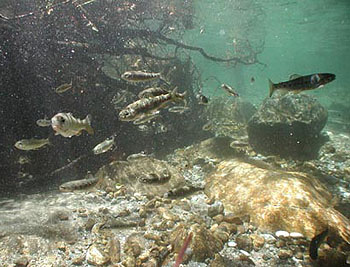The American Fisheries Society has selected a paper on steelhead trout by UC Santa Cruz researcher William Satterthwaite as the best publication for 2009 in the Transactions of the American Fisheries Society.
The paper, "Steelhead life history on California's Central Coast: Insights from a state-dependent model," presents a mathematical model for the life histories of steelhead in small coastal streams. Steelhead are rainbow trout that migrate to the sea and return to their home streams to spawn. Unlike salmon, they can spawn repeatedly, and there is great variability in the age at which they leave freshwater and when they return to spawn.
Satterthwaite, currently an assistant researcher in applied math and statistics, worked on the study as a postdoctoral researcher in the Center for Stock Assessment Research (CSTAR) at UCSC. The coauthors of the paper include Marc Mangel, professor of applied math and statistics in the Baskin School of Engineering and director of CSTAR; UCSC graduate student Michael Beakes; Erin Collins and Robert Titus of the California Department of Fish and Game; CSTAR postdoctoral researcher David Swank; Joseph Merz of Cramer Fish Sciences and the UCSC Institute of Marine Sciences; and Susan Sogard of the National Marine Fisheries Service (NMFS) Santa Cruz Laboratory.
The researchers investigated the factors that influence the life history trajectories of steelhead in Central Coast streams. Their mathematical model combined physiological and evolutionary approaches using a method (called state-dependent life history theory) developed and popularized by Mangel.
The model involves strategies that depend on age, size or condition, and recent rates of change in size or condition during specific periods in advance of the actual smolting or spawning event. By comparing the predictions of the model with empirical results from Central Coast streams, the researchers showed that the theory can explain the observed patterns and variation in the life histories and the distribution of sizes and ages at ocean migration for steelhead rearing in the upstream habitats of these streams.
"This is the first study in which such a model is fully parameterized based on data collected entirely from California steelhead populations," Mangel said.
CSTAR is a collaboration between the NMFS Santa Cruz Laboratory and UC Santa Cruz to train students and post-graduate researchers in the quantitative tools and basic science needed in fisheries management. Mangel said the recognition of Satterthwaite's work is an indication of the quality of the research being done at the center. He noted that two current graduate students affiliated with CSTAR were awarded fellowships in population dynamics this year from the highly competitive NOAA Fisheries/Sea Grant Fellowship Program.
Six of these fellowships, each of which provides $38,500 per year in research funding, were awarded nationally. Valerie Brown, a graduate student in applied mathematics and statistics, will investigate the robustness of the stock assessment process for salmon fisheries. Kate Richerson, a graduate student in ecology and evolutionary biology, had to turn down the NOAA/Sea Grant fellowship because she had already accepted a National Science Foundation graduate research fellowship. She will be studying the impact of the krill fishery in the Southern Ocean on populations of seabirds that feed on krill.



